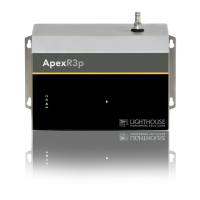ApexRp Operators Manual
248083480-1 Rev 3 46
Enable Alarming for a Channel
Alarm threshold registers are independent of each other. Any one
register’s settings will not affect the others and any channel alarms
may be enabled or disabled as the user requires. For example, to
enable alarming on just the first particle channel as shown in Table 6-
7, the user would enable Bit 1 by writing the value of ’3’ to register
43010. To disable alarming on the first channel and enable alarming
on the second channel, write a ’1’ to register 43010 and a ’3’ to
register 43012. To enable all alarms, write a ’3’ to each of the
registers 43010 and 43012.
To disable alarming completely, write a ’1’ to the enabled register or
registers (43010, 43012, 43014 or 43016).
Table 6-7 Example of Alarming on Channel 2
Use the Threshold registers to set the alarm threshold value. This is
described in the next section.
Threshold Setup Registers
Threshold data is stored in the input registers in the 45xxx series
which are read/write. All threshold data items are 4 bytes long and
are stored across 2 registers. Byte and word ordering is big-endian.
For particle channels, the threshold value is a 32-bit unsigned integer.
If the data value exceeds the threshold value and the alarm is enabled
for that channel, the threshold flag in the Data Status register (30007-
30008, bit 4) is set.
The Data Status flag is set if any of the channels have a threshold
exceeded state as true.
The threshold registers (45xxx series) shown in Table 6-8, run in
parallel with the data registers (30xxx series). For example, data
register 30010’s corresponding threshold register would be 45010.
Data register 30016’s threshold register would be 45016.
comes standard with 2
particle channels.

